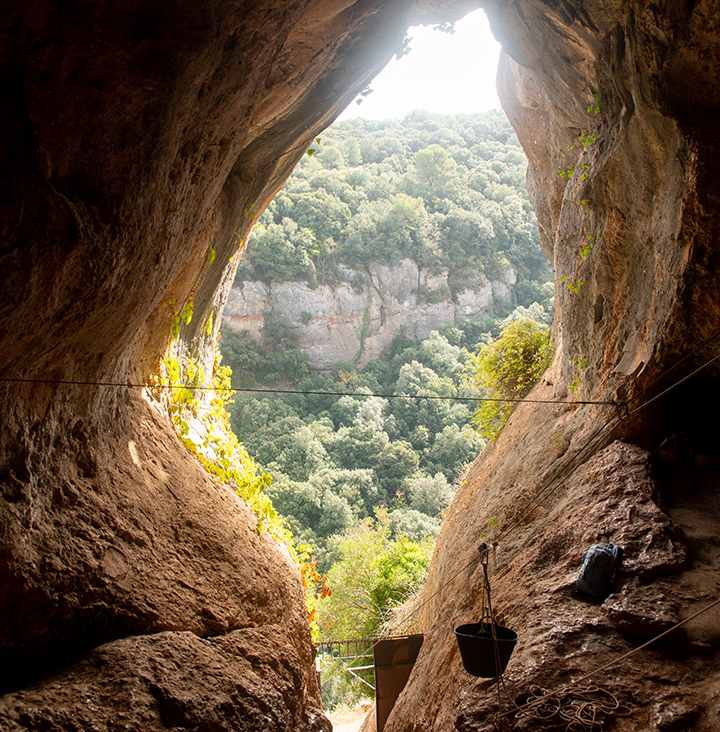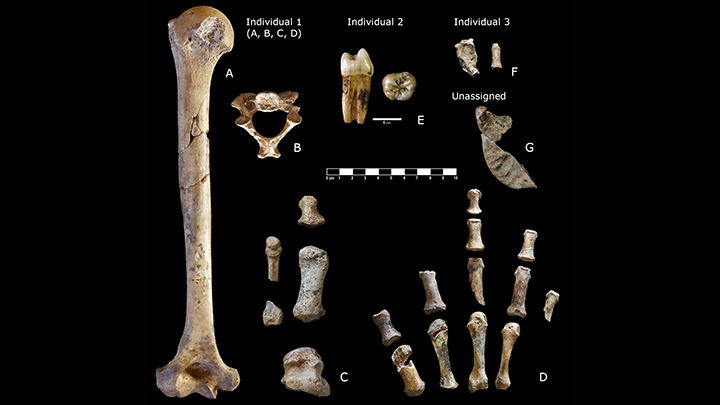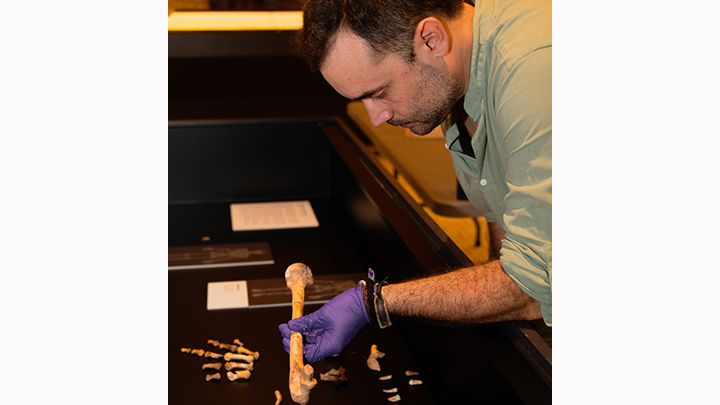Researchers identify the most important collection of Neanderthal remains in Catalonia in the Simanya Cave

The public presentation of the Neanderthal remains has coincided with the release of the scientific article "New assemblage of Late Neanderthal remains from Cova Simanya (NE Iberia)", published in the prestigious international scientific journal Frontiers in Earth Science and headed by Juan Ignacio Morales, researcher of the Catalan Institute of Human Paleoecology and Social Evolution (IPHES - CERCA center) and the Prehistoric Studies and Research Seminar (SERP) of the University of Barcelona, and Artur Cebrià, researcher at SERP, as well as by Antonio Rosas, from the National Museum of Natural Sciences (MNCN), which belongs to the Spanish National Research Council (CSIC).

The public presentation of the Neanderthal remains has coincided with the release of the scientific article "New assemblage of Late Neanderthal remains from Cova Simanya (NE Iberia)", published in the prestigious international scientific journal Frontiers in Earth Science and headed by Juan Ignacio Morales, researcher of the Catalan Institute of Human Paleoecology and Social Evolution (IPHES - CERCA center) and the Prehistoric Studies and Research Seminar (SERP) of the University of Barcelona, and Artur Cebrià, researcher at SERP, as well as by Antonio Rosas, from the National Museum of Natural Sciences (MNCN), which belongs to the Spanish National Research Council (CSIC).
Other researchers from IPHES, SERP and MNCN-CSIC, as well as from the Autonomous University of Madrid, the University of Santiago de Compostela, the University of Alicante, the Institute of Evolutionary Biology of the Pompeu Fabra University, the Catalan Institute of Paleontology, the Madrid Institute for Advanced Study (MIAS), the University of Bologna and the Museum of Natural Sciences of Barcelona have also participated in the study.
The collection is made up of 54 Neanderthal remains.
The remains they found correspond to three individuals: an adult, probably a woman; a young man (eleven or twelve years old); and a child (seven or eight years old). "From these, the adult individual stands out especially, of which remains of both arms have been identified (there is a whole humerus and a practically complete hand) and also of the feet, as well as several vertebrae and ribs", says Antonio Rosas, director of the Paleoanthropology Group of the MNCN-CSIC. Up to ten dental pieces and a jaw fragment have also been identified. Two of these teeth belong to the young individual and the remaining eight are compatible with the adult, although "we cannot rule out the possibility that they correspond to more individuals", he adds.
The set presents unequivocal anatomical features that allow it to be clearly ascribed to Neanderthals. These details not only help to differentiate these individuals from other species of the genus Homo, but also allow us to better understand the phylogeography of the Neanderthals that inhabited Europe before the arrival of the species Homo sapiens. According to Rosas, "the fossils from the Simanya Cave will help to clarify the role played by the Iberian Peninsula in the complex evolutionary history of the Neanderthals". In this sense, the researcher, one of the best international experts on Neanderthals, explains: "Today, we start to know that there are different lineages of this extinct species, but at this time we still do not know the reasons for how and where they will originate". "Iberia and the Simanya Cave have a lot to say in this regard", he predicts.
"The first dating studies indicate that the presence of Neanderthals in the Simanya Cave is older than the carbon-14 limit, i.e., older than 50,000 years", says Juan Ignacio Morales, co-director of the excavations and researcher at IPHES and SERP. The researcher also explains that alternative dating techniques that are currently being applied should make it possible to determine the age of the remains with greater precision.
Field work has confirmed not only the Neanderthals' use of the cave, but also that the cavity served as a hibernation refuge for both the brown bone and the cave bone, a use that lasted at least until 42,000 years ago. According to Morales, the cave was later used sporadically from Neolithic to much more recent times.
The Simanya Cave, a unique enclave to learn about the Neanderthals
The Simanya Cave is more than 300 meters long and, due to its accessibility, has been one of the most visited caves in Catalonia.
"One of the objectives of the Sant Llorenç del Munt i l'Obac Natural Park is to bring visitors closer to the natural and geological environment and, at the same time, to offer a space for research", explains the park's director, Àngel Miño. The geomorphology of the park, with spires, ravines, walls, chasms and caves, is one of the unique features of the area", he continues. One of the best-known caves in the Sant Llorenç mountain range is the Simanya Cave, which visitors can discover with the guided tours organized by the Barcelona Provincial Council".
The study of a set of materials deposited in the facilities of the Museum of Archaeology of Catalonia from interventions in 1978 and 1979 alerted researchers to the presence of Neanderthal remains in the Simanya cave. This prompted the researchers to initiate a research project in 2020, with the main objective of studying the human fossil remains and the archaeopaleontological context. In parallel, the recent excavation work has made it possible to reconstruct the origin and history of the Neanderthal remains, and to recover new ones. Likewise, the stone tools recovered, the animal bones processed by the Neanderthals and the documented bonfires suggest that the Simanya cave was a significant enclave for the Middle Paleolithic populations.
Central Catalonia, a key territory for the Neanderthals
The proximity of the Simanya Cave to other archaeological sites from the Middle Paleolithic, such as the Toll Caves (Moià), the Romaní Cave (Capellades) or the Collbató Cave, is evidence that Central Catalonia was a key territory for the activities and settlements of the Neanderthals during the Upper Pleistocene.
In the next excavation campaigns, the research team plans to continue the study in the Simanya karst complex, including the Triangle Cave and the Canal Cave, located just fifty meters away, with the aim of gaining a deeper understanding of the prehistoric settlement in this key area.
Institutional support and financing
Among the attendees in the event were representatives of the Department of Culture of the Catalan Government, the Barcelona Provincial Council, IPHES and the UB, as well as the director of the Museum of Archaeology of Catalonia (MAC), Jusèp Boya Busquet, and the professor of Prehistory and director of SERP, Josep Maria Fullola, together with the co-directors of the excavation, Juan Ignacio Morales and Artur Cebrià, and also Antonio Rosas, who have contextualized the site of the Simanya Cave and presented the Neanderthal remains.
From an institutional point of view, the results obtained are the product of synergies and coordinated work between the Department of Culture of the Catalan Government, through the Archaeological and Paleontological Heritage Service and the MAC, and the Barcelona Provincial Council, through Sant Llorenç del Munt i l’Obac Natural Park.
The archaeological research in the Simanya Cave is part of the four-year project Cultural Transitions during the Pleistocene and Holocene in the coastal-pre-coastal area of Catalonia (ARQ001SOL-172-2022), linked to SERP and approved by the Department of Culture, and the project PID2021-122356NB-I00, of the MNCN-CSIC and the Palarq Foundation. It also receives support from two SERP projects: PID2020-113960 (Spanish Ministry), and the one corresponding to the Quality Research Group SGR-00337 (Catalan Government). The excavations are also supported and financed by the Sant Llorenç del Munt i l'Obac Natural Park and the Barcelona Provincial Council, which have protected the site and organized guided tours.
Reference:
Morales, J. I.; Cebrià, A.; Soto, M.; Rodríguez-Hidalgo, A.; Hernando, R.; Moreno-Ribas, E.; Lombao, D.; Rabuñal, J. R.; Martín-Perea, D. M.; García-Tabernero, A.; Allué, E.; García-Basanta, A.; Lizano, E.; Marquès-Bonet, T.; Talamo, S.; Tassoni, L.; Lalueza-Fox, C.; Fullola, J. M.; Rosas, A. “A new assemblage of Late Neanderthal remains from Cova Simanya (NE Iberia)”. Frontiers in Earth Science, vol. 11, 2023. DOI: 10.3389/feart.2023.1230707.
Multimedia gallery

Figure of the Neanderthal remains of the three individuals published in the journal Frontiers in Earth Science. Author: MNCN-CSIC, IPHES.

